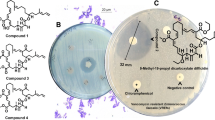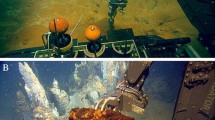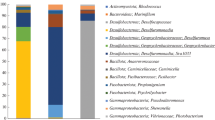Abstract
In recent years the discovery of some most important antibiotic compounds obtained by fermenting environmental microbes has been reported, providing proof that isolation and fermentation of producer strains is a significant approach to decifer novel structural types of antibiotics. Whereas many microbial taxa and environments have been well investigated in the past (e.g. soil-borne actinomycetes), the high diversity of microbial populations in certain habitats, e.g. marine sediments, has to date only been exploited marginally. Myxobacteria, the most prominent class of gliding bacteria, are well known for their ability to produce structurally intriguing natural products; however, so far no myxobacterial antibiotic has been developed for clinical use. In our studies, the antibacterial activity of the myxobacterial metabolite corallopyronin A was further investigated. Feeding studies with labeled precursors allowed to deduce all building blocks for the formation of corallopyronin A, whereby its biosynthesis from two chains probably connected by a Claisen-type reaction and the incorporation of bicarbonate into the methyl carbamate functionality can be regarded as unusual characteristics. A trans-AT type mixed PKS/NRPS gene cluster containing a β-branching cassette was identified as the putative basis for corallopyronin A biosynthesis in Corallococcus coralloides. Our research also resulted in the cultivation of several unusual marine myxobacteria which produce antibiotically active molecules.








Similar content being viewed by others
References
Belogurov GA, Vassylyeva MN, Sevostyanova A, Appleman JR, Xiang AX, Lira R, Webber SE, Klyuyev S, Nudler E, Artsimovitch I, Vassylyev DG (2009) Transcription inactivation through local refolding of the RNA polymerase structure. Nature 457:332–335
Bode HB, Müller R (2006) Analysis of myxobacterial secondary metabolism goes molecular. J Ind Microbiol Biotechnol 33:577–588
Butler MS, Cooper MA. (2011) Antibiotics in the clinical pipeline in 2011. J Antibiot (Tokyo) 64413–64425
Clardy J, Fischbach MA, Walsh CT (2006) New antibiotics from bacterial natural products. Nat Biotechnol 24:1541–1550
Coates A, Hu Y, Bax R, Page C (2002) The future challenges facing the development of new antimicrobial drugs. Nat Rev Drug Discov. 1:895–910
Davies J (2011) How to discover new antibiotics: harvesting the parvome. Curr Opin Chem Biol 15:5–10
Donadio S, Maffioli S, Monciardini P, Sosio M, Jabes D (2010) Sources of novel antibiotics. Appl Microbiol Biotechnol 88:1261–1267
Erol Ö, Schäberle TF, Schmitz A, Kehraus S, Piel J, Gurgui C, Rachid S, Müller R, König GM (2010) Biosynthesis of the myxobacterial antibiotic corallopyronin A. ChemBioChem 11:1253–1265
Fabbretti A, Gualerzi CO, Brandi L (2011) How to cope with the quest for new antibiotics. FEBS Lett 585:1673–1681
Fischbach MA (2009) Antibiotics from microbes: converging to kill. Curr Opin Microbiol 12:520–527
Fudou R, Iizuka T, Yamanaka S (2001a) Haliangicin, a novel antifungal metabolite produced by a marine myxobacterium. 1. Fermentation and biological characteristics. J Antibiot (Tokyo) 54:149–152
Fudou R, Iizuka T, Sato S, Ando T, Shimba N, Yamanaka S (2001b) Haliangicin, a novel antifungal metabolite produced by a marine myxobacterium. 2. Isolation and structural elucidation. J Antibiot (Tokyo) 54:153–156
Fudou R, Jojima Y, Iizuka T, Yamanaka S (2002) Haliangium ochraceum gen. nov., sp.nov. and Haliangium tepidum sp. nov.: Novel moderately halophilic myxobacteria isolated from coastal saline environments. J Gen Appl Microbiol 48:109–115
Gross H (2009) Genomic mining—a concept for the discovery of new bioactive natural products. Curr Opin Drug Discov Devel 12:207–219
Hamad B (2010) The antibiotics market. Nat Rev Drug Discov. 9:675–676
Hughes CC, Fenical W (2010) Antibacterials from the sea. Chem Eur J 16:12512–12525
Iizuka T, Jojima Y, Fudou R, Hiraishi A, Ahn JW, Yamanaka S (2003a) Plesiocystis pacifica gen. nov., sp. nov., a marine myxobacterium that contains dihydrogenated menaquinone, isolated from the Pacific coasts of Japan. Int J Syst Evol Microbiol 53:189–195
Iizuka T, Jojima Y, Fudou R, Tokura M, Hiraishi A, Yamanaka S (2003b) Enhygromyxa salina gen. nov., sp. nov., a slightly halophilic myxobacterium isolated from the coastal areas of Japan. Syst Appl Microbiol 26:189–196
Irschik H, Jansen R, Höfle G, Gerth K, Reichenbach H (1985) On antibiotics from gliding bacteria. The corallopyronins, new inhibitors of bacterial RNA-synthesis from myxobacteria. J Antibiot (Tokyo) 38:145–152
Irschik H, Schummer D, Höfle G, Reichenbach H, Steinmetz H, Jansen R (2007) Etnangien, a macrolide-polyene antibiotic from Sorangium cellulosum that inhibits nucleic acid polymerase. J Nat Prod 70:1060–1063
Jansen R, Irschnik H, Reichenbach H, Höfle G (1985) Corallopyronin A, corallopyronin B, and corallopyronin C—3 novel antibiotics from Corallococcus coralloides. Liebigs Ann Chem 4:822–826
Kusebauch B, Busch B, Scherlach K, Roth M, Hertweck C (2010) Functionally distinct modules operate two consecutive α, β→β, γ double-bond shifts in the rhizoxin polyketide assembly line. Angew Chem Int Ed Engl 49:1460–1464
Li YZ, Hu W, Zhang YQ, Qiu ZJ, Zhang Y, Wu BH (2002) A simple method to isolate salt-tolerant myxobacteria from marine samples. J Microbiol Methods 50:205–209
Liu X, Ashforth E, Ren B, Song F, Dai H, Liu M, Wang J, Xie Q, Zhang L (2010) Bioprospecting microbial natural product libraries from the marine environment for drug discovery. J Antibiot (Tokyo) 63:415–422
Menche D, Arikan F, Perlova O, Horstmann N, Ahlbrecht W, Wenzel SC, Jansen R, Irschik H, Müller R (2008) Stereochemical determination and complex biosynthetic assembly of etnangien, a highly potent RNA polymerase inhibitor from the myxobacterium Sorangium cellulosum. J Am Chem Soc 130:14234–14243
Moldenhauer J, Götz DC, Albert CR, Bischof SK, Schneider K, Süssmuth RD, Engeser M, Gross H, Bringmann G, Piel J (2010) The final steps of bacillaene biosynthesis in Bacillus amyloliquefaciens FZB42: direct evidence for beta, gamma dehydration by a trans-acyltransferase polyketide synthase. Angew Chem Int Ed Engl 49:1465–1467
Mukhopadhyay J, Das K, Ismail S, Koppstein D, Jang M, Hudson B, Sarafianos S, Tuske S, Patel J, Jansen R, Irschik H, Arnold E, Ebright RH (2008) The RNA polymerase “switch region” is target for inhibitors. Cell 135:295–307
Mullane KM, Gorbach S (2011) Fidaxomicin: first-in-class macrocyclic antibiotic. Expert Rev Anti Infect Ther 9:767–777
Nett M, König GM (2007) The chemistry of gliding bacteria. Nat Prod Rep 24:1245–1261
O’Neill A, Oliva B, Storey C, Hoyle A, Fishwick C, Chopra I (2000) RNA polymerase inhibitors with activity against rifampin-resistant mutants of Staphylococcus aureus. Antimicrob Agents Chemother 44:3163–3166
Payne DJ, Gwynn MN, Holmes DJ, Pompliano DL (2007) Drugs for bad bugs: confronting the challenges of antibacterial discovery. Nat Rev Drug Discov 6:29–40
Piel J (2010) Biosynthesis of polyketides by trans-AT polyketide synthases. Nat Prod Rep 27:996–1047
Projan SJ (2003) Why is big pharma getting out of antibacterial drug discovery? Curr Opin Microbiol 6:427–430
Reichenbach H (1993) Biology of myxobacteria: ecology and taxonomy. In: Dworkin M, Kaiser D (eds) Myxobacteria II. American Society for Microbiology, Washington, DC, pp 13–62
Reichenbach H (2001) Myxobacteria, producers of novel bioactive substances. J Ind Microbiol Biotechnol 27:149–156
Schäberle TF, Goralski E, Neu E, Erol Ö, Hölzl G, Dörmann P, Bierbaum G, König GM (2010) Marine myxobacteria as a source of antibiotics—Comparison of the physiology, polyketide-type genes and antibiotic production of three new isolates of Enhygromyxa salina. Marine Drugs 8:2466–2479
Schiefer A, Schmitz A, Schäberle TF, Specht S, Lämmer C, Johnston KL, Vassylyev DG, König GM, Hoerauf A, Pfarr K (2012) Corallopyronin A specifically targets and depletes essential obligate Wolbachia endobacteria from filarial nematodes in vivo. J Infect Dis (in press)
Schneiker S, Perlova O, Kaiser O, Gerth K, Alici A, Altmeyer MO, Bartels D, Bekel T, Beyer S, Bode E et al (2007) Complete genome sequence of the myxobacterium Sorangium cellulosum. Nat Biotechnol 25:1281–1289
Singh SB, Young K (2010) New antibiotic structures from fermentations. Expert Opin Ther Pat 20:1359–1371
Wenzel SC, Müller R (2009) The biosynthetic potential of myxobacteria and their impact in drug discovery. Curr Opin Drug Discov Dev 12:220–230
Author information
Authors and Affiliations
Corresponding author
Rights and permissions
About this article
Cite this article
Schmitz, A., Felder, S., Höver, T. et al. Antibiotics from gliding bacteria. Phytochem Rev 12, 507–516 (2013). https://doi.org/10.1007/s11101-012-9224-x
Received:
Accepted:
Published:
Issue Date:
DOI: https://doi.org/10.1007/s11101-012-9224-x




